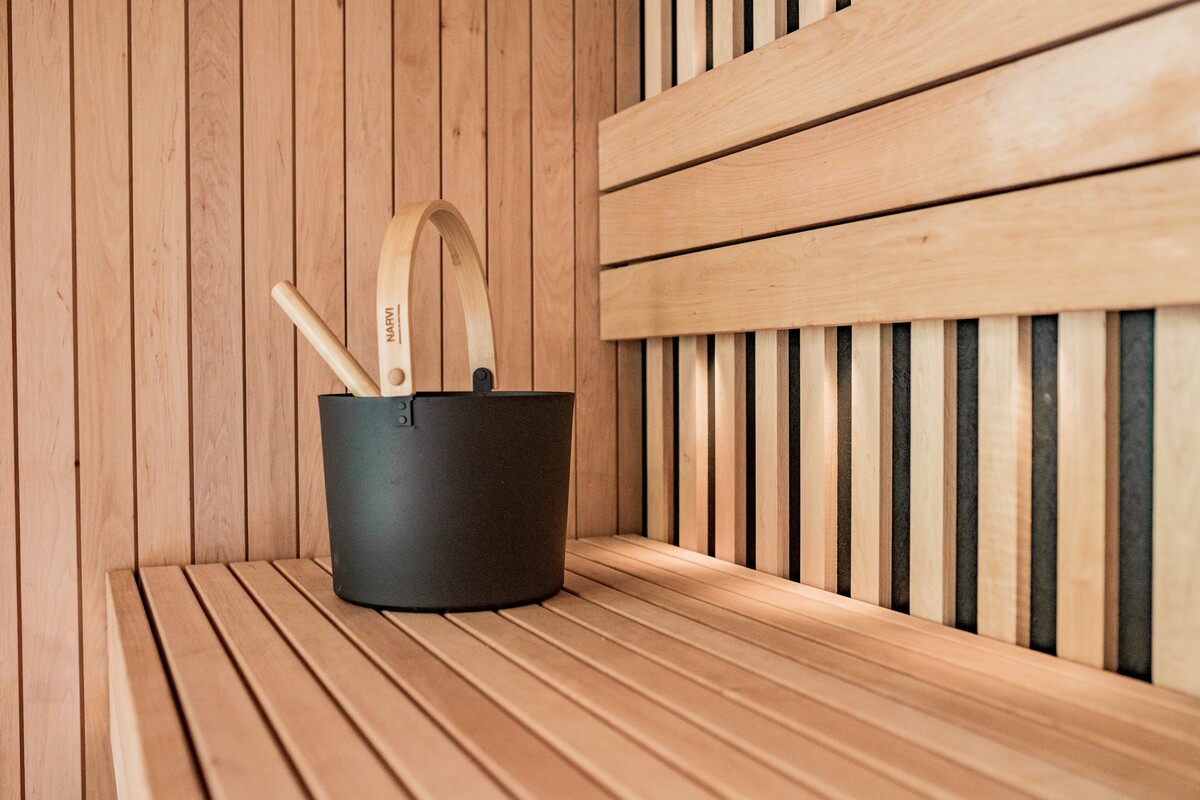We found out what your body thinks about regular visits to the sauna.
The average Finn visits a sauna roughly two to three times a week. If everything that is said about the positive effects of sauna use were true, doctors in this country would probably lose their jobs. This ritual is supposed to rid you of all toxic substances, eliminate joint and muscle pain, and improve your immunity and mood. While some of this is certainly true, many of the claims are far from backed up by scientific evidence.
There are several types of saunas, but in this article we will focus on the traditional Finnish sauna. This is characterised by dry air and a high temperature of between 80 and 100 °C. The humidity is usually between 10 and 20%, which is similar to the deck of an aeroplane.

You can sweat up to a litre of sweat
When you walk into a sauna, you don't start sweating right away. Your skin temperature rises gradually, and your body only starts to need to cool down when it reaches about 37 °C. A standard long stay in a Finnish sauna usually reaches 41 °C. Your body temperature will also rise slightly. During a 20-minute sauna session, you may sweat out as much as half a litre to a litre of sweat.
The intense heat activates the autonomic nervous system, which literally "jump-starts" your heart. Your heart rate will jump by at least 30% in the sauna. This means that even your resting pulse rate of 80 beats per minute (bpm) in the sauna can exceed 104 bpm (the equivalent of walking). This allows the heart to nearly double the amount of blood it pumps to be able to cool the body. However, the heart actually diverts some of it away from the internal organs and directs most of it to the skin.
In such a hot environment, you probably won't be in the mood for fried schnitzel. That's because the appetite-regulating hormones don't work ideally at temperatures above 30 °C. In fact, heat increases the levels of leptin in the blood, which suppresses appetite.
An experiment on nine healthy 20-year-old men showed that it takes about three more hours (up to six hours in milder forms) for the body to return to normal.
Hot environments have an unpredictable effect on blood pressure - some people's blood pressure rises, others' drops, according to Harvard researchers. Because it's difficult to know whether sauna bathing can be beneficial or harmful, doctors prefer not to recommend it to patients with heart problems.
Levels of some hormones will also rise during a short stay in the sauna. One of these is the stress hormone cortisol, norepinephrine, which increases alertness, and adrenaline. Testosterone levels remain the same.
For men, being in a sauna may weaken sperm for a while, but experts say that this effect is only short-lived and they will "come back to life" after cooling down (one of the many reasons why a spa is not the ideal place to procreate).
The heart thinks you're riding a bike
A Finnish study on middle-aged men found interesting associations between sauna use and a lower risk of cardiovascular problems. According to the researchers, this is because this short-term exertion makes the heart stronger.
So in this respect, sauna bathing resembles gentle exercise - for example, a light ride on a stationary bike, the researchers say. Of course, this doesn't mean that sitting in a sauna is as beneficial as exercise - but the circulatory system responses are very similar.

Evidence from many experimental and epidemiological studies suggests that sauna bathing may even modify blood pressure. A single longitudinal study of 1621 men found that men who sauna frequently (4- to 7-times per week) had about a 47% lower risk of developing hypertension than those who sauna only once a week. The study also found a significantly lower risk of dementia and Alzheimer's disease in this group.
However, most of the studies involved patients with pre-existing heart disease or assessed only the short-term effects of sauna use. Still, patients with any cardiovascular problems should consult their doctor in the first instance, and also beware of alternating heat and cold too rapidly.
Toxins? About a tenth of a nanogram
It is said that we go to the sauna to "sweat out the toxins". It's not quite like that. We sweat primarily to cool down, not to excrete waste or toxic substances, experts tell National Geographic.
Although sweat is made up mostly of water, it can contain trace amounts of hundreds of substances, including toxic ones. However, many of these reach very low levels.
More than 99% of sweat is water, the rest is made up of minerals such as sodium and calcium, plus small amounts of various proteins, lactic acid and urea. Urea - which is produced in the liver by the breakdown of proteins in food - may be a waste product, but the process of sweating is fairly unimportant in flushing it out. In fact, our kidneys and liver are primarily responsible for detoxifying the body, so you get rid of them in a little need rather than in a sauna.
Imagine the following example. If you're active, you can sweat two litres in one day. Physiologists at the University of Ottawa in Canada have found that this amount of sweat contains less than one-tenth of a nanogram of toxins, which is a pretty negligible amount.
You won't lose weight by sauna either. This misconception of the fitness industry is based on the fact that your body loses a lot of water through sweating. So yes, you'll weigh a little less after a sauna, but once you've replenished the necessary fluids and food, you'll be right back where you were.
Prevention of colds
The beneficial effect of sauna bathing on the respiratory system has long been known. Sauna can cause transient improvement of lung function in patients with obstructive lung disease or improve breathing in patients with asthma or chronic bronchitis.

If you are often ill, sauna can be a pretty good preventive measure, according to the findings so far. In an earlier study, 25 volunteers attended a sauna for six months. After just three months, the incidence of colds in this group was cut in half. The new findings show that two to three sauna stays per week are enough to reduce the risk of respiratory illness.
A sauna alone probably won't miraculously boost your immune system, but it can calm you down, reduce stress levels, flush out endorphins and improve sleep, all of which have an equally powerful effect on boosting immunity.
Try it after your workout
Sauna can also be a good solution to recurring headaches, muscle and joint pain. The clash of heat and cold has analgesic effects on the body. Previous studies have reported that an 8-week sauna session improved symptoms of chronic tension headaches.
That said, a visit to the sauna after a workout is probably a good choice, and not just for the sake of relaxing your muscles. In 2019, this assumption was tested - how different - by Finnish researchers on 48 people. They divided them into three groups: the first was a control group with a largely sedentary lifestyle, the second consisted of people who exercised three times a week, and the third was people who exercised while going to the sauna for 15 minutes after their workout.
After eight weeks, they looked at the results. The exercise-only group was in better shape and had less body fat. However, the group that both exercised and went to the sauna had lower blood pressure and cholesterol, in addition to being in better shape.
Finally, sauna can improve the overall quality of health, even in old age. A Finnish cross-sectional analysis of 524 octogenarians found that those who had sauna baths throughout their lives had better physical function, vitality, social functioning and overall health levels.
Who shouldn't go to the sauna?
Under no circumstances should you go to the sauna drunk, dehydrated, with fever, infections, rosacea, atopic dermatitis or hives. Not only people with cardiovascular problems, but also pregnant women should consult a doctor before visiting a sauna.

Most of the deaths that occurred in saunas were at least partly due to alcohol consumption. This combination significantly increases the risk of high blood pressure, heart complications and traumatic events.
At present, it is not entirely clear whether steam saunas induce the same degree of physiological reactions as dry saunas, as the higher humidity causes condensation on the skin and reduced evaporation of sweat. However, any heat stress, whether induced by infrared or Finnish saunas, will induce similar cardiovascular and metabolic effects.




